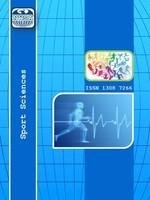9-11 YAŞ GRUBU SERBEST YÜZÜCÜLERDE KULAÇ UZUNLUĞU VE SIKLIĞININ PERFORMANSA ETKİSİ
Bu çalışmada 9-11 yaş grubu arasındaki yüzme sporcularında kulaç uzunluğu ve kulaç sıklığının performansa etkisinin incelenmesi amaçlanmıştır. Yeşilyurt Spor Kulübünden 23 erkek ve 17 kız sporcudan oluşan toplam 40 sporcu araştırmaya katılmıştır. Sporcuların 50 metre ve 100 metrelik serbest stil yüzme derecelerine bakılmış ve sualtı kamerasıyla kol devir sayıları tespit edilmiştir. Elde edilen veriler SPSS 17.0 istatistik programında aritmetik ortalama standart sapmaları hesaplanmış ve verilerin karşılaştırılmasında Mann Whitney U testi uygulanmıştır. Korelasyonların hesaplanmasında parametrik olmayan testlerden sperman uygulanmıştır. Araştırma sonucunda; bayan ve erkek yüzücülerin 100 m kulaç uzunlukları ile kulaç sıklıkları ve hızları arasında istatistiksel açıdan anlamlı ilişkilerin olduğu sonucuna ulaşılmıştır (p0,05), kulaç sıklıkları ile kulaç uzunlukları arasında ise istatistiksel açıdan anlamlı ilişki olduğu belirlenmiştir (p
Anahtar Kelimeler:
Kulaç Uzunluğu, Kulaç Sıklığı, Serbest Stil Yüzme, Performans, Yüzücü,
EFFECT OF STROKE LENGTH AND STROKE FREQUENCY ON PERFORMANCE FOR CRAWL SWIMMERS IN 9-11 AGE GROUPS
The aim of this study was to evaluation the effect of stroke length and stroke frequency on performance for crawl swimmers in 9-11 age groups. Totally 40 athletes including 23 males and 17 females from Yesilyurt Sports Club participated to the study. 50 meters and 100 meters crawl swimming rankings of the athletes were viewed and their arm revolutions were determined by an underwater camera. It was concluded that there was a significant relation statistically between stroke lengths of 100 meters female and male athletes and their stroke frequency and pace (p0,05), but there was a remarkable relation statistically between the stroke frequency and stroke length (p>0,05). Obtained data was analyzed in SPSS 17.0 statistics software. Standard deviations of the arithmetic means of the values were calculated and Mann Whitney U test was applied for comparison. In the measure of the correlations spearman, one of the nonparametric tests was applied. Results also showed that values of 50 meters and 100 meters of female and male swimmers change statistically according to their sex and age.
Keywords:
Stroke Length, Stroke Frequency, Crawl Swimming, Performance, Swimmer, ,
- Başlangıç: 2009
- Yayıncı: E-Journal of New World Sciences Academy
Sayıdaki Diğer Makaleler
Yakup Aktaş, Fatma İlker KERKEZ
FİBROMİYALJİ SENDROMLU HASTALARDA EGZERSİZ VE SF-36 YAŞAM KALİTESİ İLİŞKİSİNİN İNCELENMESİ
SPOR EĞİTİMİNDE BİLGİ VE İLETİŞİM TEKNOLOJİLERİNİN KULLANIMI
Ali SERDAR YÜCEL, Sebahattin DEVECİOĞLU
TÜRKİYE`DE RAKET SPORLARI ALANINDA YAPILAN LİSANSÜSTÜ TEZLERİN İNCELENMESİ
Füsun ÖZTÜRK KUTER, Yusuf OZTURK
9-11 YAŞ GRUBU SERBEST YÜZÜCÜLERDE KULAÇ UZUNLUĞU VE SIKLIĞININ PERFORMANSA ETKİSİ
